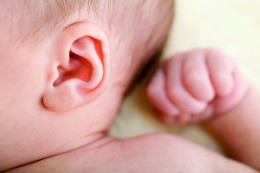Ear infection in babies is also referred to as acute otitis media. It occurs when the area between the outer ear and inner/middle ear gets inflamed, infected and clogged with fluid. The resulting inflammation of this area causes the eardrum to bulge and become red in addition to pain and fever symptoms. This condition is among the most common childhood sicknesses and targets children under 4 years old.
What Causes Ear Infection in Babies?
The short immature Eustachian tube is one of the primary causes of this condition. The Eustachian tube connects the back of the nose to the middle ear. Bacteria from the throat and nose can access the middle ear easily. Colds also result in ear infections because of the accumulation of mucus at the back of the nose, consequently providing a breeding environment for the bacteria. Similarly, the middle ear produces mucus, which when fed on by germs results in the formation of pus and thick mucus. The accumulation of pus leads to the bulging and redness of the eardrum, causing the child to experience pain. Hearing ability will also be affected since the discharge pressing on the eardrum interferes with its vibrations. The conduction of the vibrations to the small bones is also hampered.
How Would I Know It’s an Ear Infection?

Finding about an ear infection in babies can be hard since they are not capable of communicating what they feel. If you are a parent, you should look out for the following signs:
- A fever that is above 102°F (39°C).
- Heightened irritability and crying, particularly when they’re lying down. This may indicate pain caused by pressure build up on the Eustachian tubes as observed during an ear infection.
- Problems with sleeping.
- Vomiting, decreased appetite, or diarrhea.
- Unresponsiveness to sound.
- Pus or fluid flowing out of the baby’s ear. This could be a sign of a punctured eardrum that occurs as a result of too much pressure caused by the fluid in the middle ear.
- A crust forming around the ear.
- Imbalance due to dizziness.
How to Deal With Ear Infection in Babies
Are Antibiotics Necessary?
Antibiotics have been the standard prescription for ear infections for years, but it is now revealed that they are not the best treatment option. Researchers found that 80% of ear infection in babies clears up on its own in around 3 days without antibiotics. Unnecessary use of antibiotics can lead to the bacteria becoming more resilient. It is for this reason that the American Academy of Family Physicians recommends holding off antibiotics for 2-3 days in most cases.
However, in some cases antibiotics are necessary. Prescription is recommended when dealing with:
- Children under the age of 6 months
- Children between the ages of 6 month to 12 years with serious symptoms
Call your doctor if your baby’s symptoms did not improve after a few days of getting the ear infection. If antibiotics are prescribed, be sure to let your child finish the full course. A follow-up examination by the doctor may be performed to check how the medication has worked.
If antibiotics did not seem to work after taking it for a couple of days, the doctor may perform another examination on your child or change the prescription of medications.
Home Remedy
- Warm compress
To decrease the pain, you can place a warm compress on your baby’s ear for 10 to 15 minutes.
- Acetaminophen
If your baby is 6 months or older, you can administer acetaminophen to ease the pain. Follow the doctor’s instructions when using drugs and read the instructions on the packaging. For best results, give the medication before bed.
- Warm oil
If you do not suspect a perforated eardrum, and there is no fluid draining from the baby’s ear, you can put a few drops of warm or room temperature sesame or olive oil in the baby’s ear.
- Keep hydrated
Giving your baby fluids can help. Swallowing helps drain the fluid trapped in the Eustachian tube.
- Elevate baby’s head
To deal with ear infection in babies, ensure the baby’s head is elevated when sleeping. Place a pillow under the mattress and not under the baby’s head. This will help with the sinus drainage.
- Homeopathic eardrops
Homeopathic ear drops have extracts from natural ingredients like calendula, lavender, mullein, garlic and St. John’s wort found in olive oil. They are all helpful in relieving pain and inflammation.
Can Ear Infections in Babies Be Prevented?
There is no sure way of doing it, but you can reduce the risk of ear infections in babies by:
- Breastfeeding for the first year. The risk of ear infections is reduced by the antibodies found in breast milk. When bottle feeding, ensure the baby is sitting upright as milk easily flows to the middle ear if the baby is lying down.
- Try preventing colds as much as possible. Keeping the baby’s hands clean and reduce the time spent in groups/crowds to help decrease the chances of getting a cold.
- Follow up on your baby’s allergies. Mucus can lead to blockage of the Eustachian tube, which later leads to an infection.
- Avoid smoking. Babies who are exposed to second-hand smoke have a higher risk of getting ear infections.
- Vaccination also helps. Ask for meningitis, flu and pneumococcal vaccines. Research reports that babies who are vaccinated are less likely to get ear infections.
